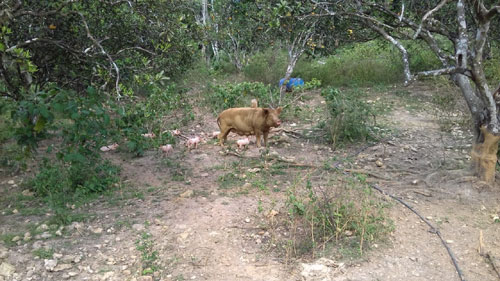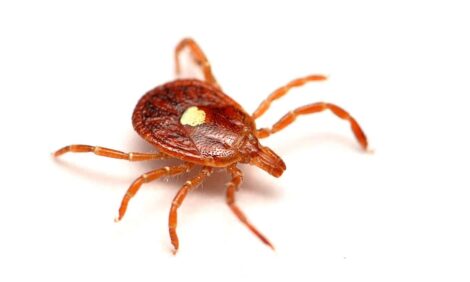



Inside a Thriving Jamaican Pork Farm
Pig products are big in Jamaica – it’s not just Usain Bolt who loves his jerk pork. But what’s the current outlook for domestic producers? To find out, Stuart Lumb heads to a Montego Bay family business to get a farmer’s-eye perspective.
Jamaicans, like most Caribbeans, love their chicken – but pork is very popular as well. Jerk pork is pork that’s wet marinated or dry rubbed with a hot-spice mixture and, supposedly, is a certain world-famous Jamaican sprinter’s favourite meal. It can be bought in restaurants or on street corners, and is sold by a multitude of friendly vendors.
The Jamaican pig population stands at around 80,000 sows, which are the basis for a very diverse industry. Operations range from large, intensive farrow-to-finish units that embrace the best technology available – such as tunnel ventilation – to small, backyard producers who keep a few sows, producing enough pigs to satisfy the needs of family and friends. In between are producers who keep anything from 50 up to several hundred sows.
Annabel Williams farms 2,000 acres (833 ha) in the west of Jamaica, roughly 45 minutes’ drive south of Montego Bay. Jamaica’s inland terrain is quite hilly and ambient temperatures on Williams’s farm, Kew Park, are quite a bit lower than the 28-30°C averages found at sea level, 1,000 feet (305m) below.
Williams farms with her brother, employing 12 full-time and five part-time staff. Most of the farm is lush forest, but it supports a beef herd of Jamaican Red cattle (Hereford/Brahman crosses), a sheep flock and a broiler unit as well as the pigs. A recent development has been harvesting bamboo as a source of charcoal, which provides enough yield for export as well as for the domestic market. The farm supports a number of hardwood species which are being selectively felled and replaced. “This is a long-term venture which the next generation will benefit from,” says Williams.
The pig business was started by Williams’s mother and initially consisted of four gilts and a boar. The operation expanded, with weaners bought in from a number of local breeders. However this type of production eventually collapsed because of the number of diseases, such as coccidiosis, the new pigs had brought with them.
Just like anywhere else in the world, the Jamaican pig industry is cyclical, and producers have to contend with imports from the USA, Canada and Brazil. A recent development has been the establishment in 2002 of the Jamaica Pig Farmers Association (JPFA), first chaired by Williams, which has a fruitful dialogue with government and has been able to limit the amount of pork being imported into Jamaica. Some years ago Williams was selling 120 to 150 finishers per week, but the vagaries of the local industry meant that output has since been reduced to 20 to 30 finishers per week.
Sows are all Yorkshire/Landrace swine crossed with Duroc, either naturally or using artificial insemination. Some F1 gilts have also been bought in, which originate from Jamaica-based Newport Genetics who in turn have sourced boars and gilts from Canada. Williams’s gilts cost between £400 and £500 each – which is not cheap, given that the average annual wage in Jamaica stands at around £14,000. Consequently Williams has her own internal gilt-selection programme which means a number of her sows are F2s. “There is no specific culling age, with many sows getting into double figures litter-wise, as long as they keep producing decent litters,” she says.
With the focus on low-cost production, Williams’s sows and gilts spend most of their lives outdoors. “Other benefits are that the pigs do a great job of clearing the undergrowth and also turning the soil over (as sows and gilts are not rung), saving the costs of conventional ploughing.”
Piglets are only handled for castration; tails are left on and the piglets ingest iron while rooting – they also eat some of the sow feed. Sows and litters are rounded up for weaning at four weeks, after which time the breeding females are housed in the service accommodation, which is all solid floored and naturally ventilated. Pens are fitted with nipple drinkers which are gravity fed from elevated storage tanks. Rainwater accumulates in lagoons located all over the farm, with the water then being pumped into the above-ground containers.
The area has an annual rainfall of 90 inches (230mm), which is distributed evenly throughout the year, so lack of water is generally not a problem. “We have never run out of water – we’ve come close a few times, but we are careful and try and avoid any wastage,” says Williams.
Feeding is carried out by hand with floor feeding being the norm. All the unit feed is bought from Nutramix and is manufactured and bagged by Newport Mills Ltd, Kingston, and the bagged feed travels a distance of 150km (93 miles) from the capital. “Bagged feed suits my operation”, says Williams. “It’s more convenient than bulk feed plus our bumpy narrow roads don’t lend themselves to carrying large eight-wheeler bulkers.”
Feeds in Jamaica are typically based on imported corn and soya, with these raw materials coming in from the USA. An attempt was made recently to grow sorghum on the island, in an effort to reduce the dependency on imported grains, but sadly this failed. Williams says she would like to be organic but the feedstuffs from the USA are not GM free.
In terms of breeding, sows are served twice over a 24-hour period, with semen bought in from Newport Genetics at a cost of £19 for a double insemination (the semen is couriered in from the AI stud, near Kingston). Sows and gilts are kept adjacent to the boars for at least four weeks, to pick up any three-week returns, after which they are allowed to roam freely.
Williams feeds a single 12.5 per cent crude protein (CP) breeder feed to all her breeding pigs. She mixes it with an 18 per cent CP starter feed for the lactating sows, which boosts the level of protein and amino acids. Naturally the piglets can pick out the starter and so it’s an ingenious way of getting the piglets to start eating solid feed.
The grower and finisher accommodation, which is some distance from the breeding pens, is also solid-floored and naturally ventilated. Manure is manually scraped out daily and used as fertiliser, with the pens being flushed down daily with water. Pigs are initially fed prestarter feed (18 per cent CP) up to 12kg, starter feed (18 per cent CP), followed by grower feed (15 per cent CP) and finally finisher feed (14 per cent CP). Both the grower and finisher contain 25ppm zinc bacitracin, which is added as a growth promoter, while the starter contains 40g per tonne of the antibiotic Tylosin.
Williams did buy ad lib hoppers to save labour and improve performance. However, she found they offered little benefits, so she reverted to floor feeding, which is, of course, more labour intensive. “Unemployment is very high in our rural areas and I’m happy to reduce that if I can,” she says.
As well as being a highly competent pig farmer Williams owns her own own slaughter facility and is a fully qualified slaughterer. She has to pass an exam each year and must purchase an operating licence to maintain her qualification, but keeping the slaughtering operation in-house is another way of reducing costs. Carcasses have an average dead weight of 70kg and kill out at 65 per cent, which excludes the head and trotters.
Over the past few years shrinking margins have led many producers to move “beyond the farm gate” and get involved in selling cuts and processed products themselves, rather than carcasses alone. Carcass returns are somewhat depressed currently, with joints and cuts grossing J$220 to J$245 per pound (£3.08 to £3.41 per kilo).
Williams currently delivers to 35 customers including small shops, and given that she keeps her pigs on a welfare-focused system, sales of Kew Park pork are steadily increasing. Consumers are increasingly concerned about their food’s traceability. Buying your pork from the person who farms the pigs makes for an extremely short supply chain and has become a key selling point for Kew Park pork – plus selling direct helps the bottom line a great deal.
Despite this, the business generally only makes a modest profit margin, except when pigs are in very short supply on the island. Making money rearing pigs is always a roller-coaster business, but Annabel Williams is a very determined and focused entrepreneur – and odds on she will still be in business when many of her competitors have fallen by the wayside.
May 2017








